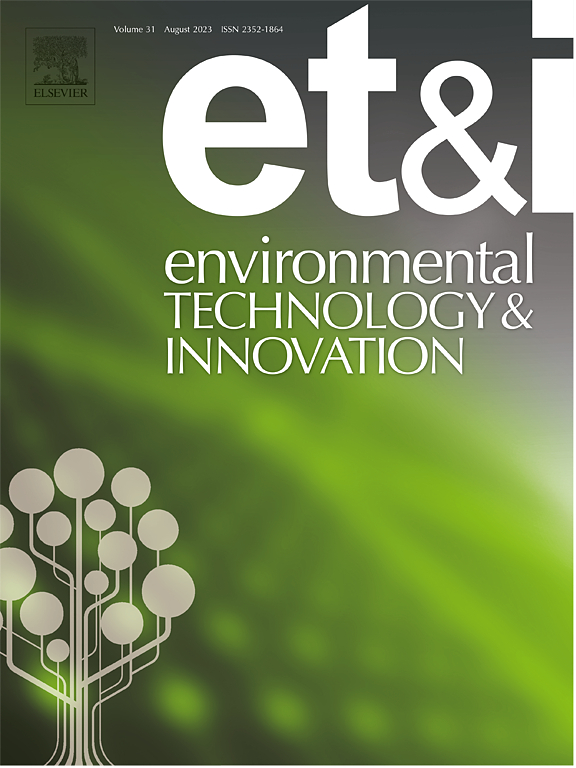Effects of co-inoculation with Bradyrhizobium and Trichoderma harzianum on soybean nitrogen nutrition and multispectral traits
IF 6.7
2区 环境科学与生态学
Q1 BIOTECHNOLOGY & APPLIED MICROBIOLOGY
引用次数: 0
Abstract
This study evaluates the potential of co-encapsulated native Bradyrhizobium spp. strains and Trichoderma harzianum T1, delivered via biodegradable microparticles, to enhance growth, nitrogen uptake, and physiological performance in soybean (Glycine max L.). The microbial consortium was applied to soybean roots to assess synergistic effects on biological nitrogen fixation and plant development. Native Bradyrhizobium strains exhibited high tolerance to environmental stressors, including elevated temperatures, low pH, and salinity, and all produced indole-3-acetic acid (IAA), supporting their role as plant growth-promoting rhizobacteria. The most effective strains in improving nitrogen content were S1, S2, and S3, while S5, S4, and S3 were most effective in promoting dry biomass accumulation. Inoculation with T. harzianum increased shoot nitrogen content by an average of 0.2 % over rhizobial-only treatments. Co-inoculation with T. harzianum and specific rhizobial strains (S1, S4, S6) led to synergistic effects, significantly enhancing plant dry weight, nodule biomass, and multispectral traits. Multispectral imaging, combined with principal component analysis, revealed treatment-specific physiological responses that were not evident from biomass or nitrogen measurements alone, highlighting its sensitivity in detecting microbial effects on plant health. These findings support the application of encapsulated microbial consortia as a sustainable strategy to improve soybean productivity under diverse environmental conditions.
缓生根瘤菌和哈茨木霉共接种对大豆氮素营养及多光谱性状的影响
本研究评估了原生缓生根瘤菌菌株和哈兹木霉T1共包被的潜力,通过可生物降解微颗粒输送,促进大豆(Glycine max L.)的生长、氮吸收和生理性能。以大豆根系为研究对象,研究了微生物群落对生物固氮和植物发育的协同效应。原生缓生根瘤菌菌株对高温、低pH和盐度等环境胁迫具有较高的耐受性,并均产生吲哚-3-乙酸(IAA),支持其作为植物生长促进根瘤菌的作用。提高氮素含量最有效的菌株是S1、S2和S3,而促进干生物量积累最有效的菌株是S5、S4和S3。接种哈兹根霉比只接种根瘤菌的处理平均增加了0.2 %的茎部氮含量。哈兹兰与特定根瘤菌(S1、S4、S6)共接种产生协同效应,显著提高植株干重、根瘤生物量和多光谱性状。多光谱成像与主成分分析相结合,揭示了生物量或氮单独测量不明显的处理特异性生理反应,突出了其在检测微生物对植物健康影响方面的敏感性。这些研究结果支持了在不同环境条件下,应用包封菌群作为一种可持续的策略来提高大豆生产力。
本文章由计算机程序翻译,如有差异,请以英文原文为准。
求助全文
约1分钟内获得全文
求助全文
来源期刊

Environmental Technology & Innovation
Environmental Science-General Environmental Science
CiteScore
14.00
自引率
4.20%
发文量
435
审稿时长
74 days
期刊介绍:
Environmental Technology & Innovation adopts a challenge-oriented approach to solutions by integrating natural sciences to promote a sustainable future. The journal aims to foster the creation and development of innovative products, technologies, and ideas that enhance the environment, with impacts across soil, air, water, and food in rural and urban areas.
As a platform for disseminating scientific evidence for environmental protection and sustainable development, the journal emphasizes fundamental science, methodologies, tools, techniques, and policy considerations. It emphasizes the importance of science and technology in environmental benefits, including smarter, cleaner technologies for environmental protection, more efficient resource processing methods, and the evidence supporting their effectiveness.
 求助内容:
求助内容: 应助结果提醒方式:
应助结果提醒方式:


